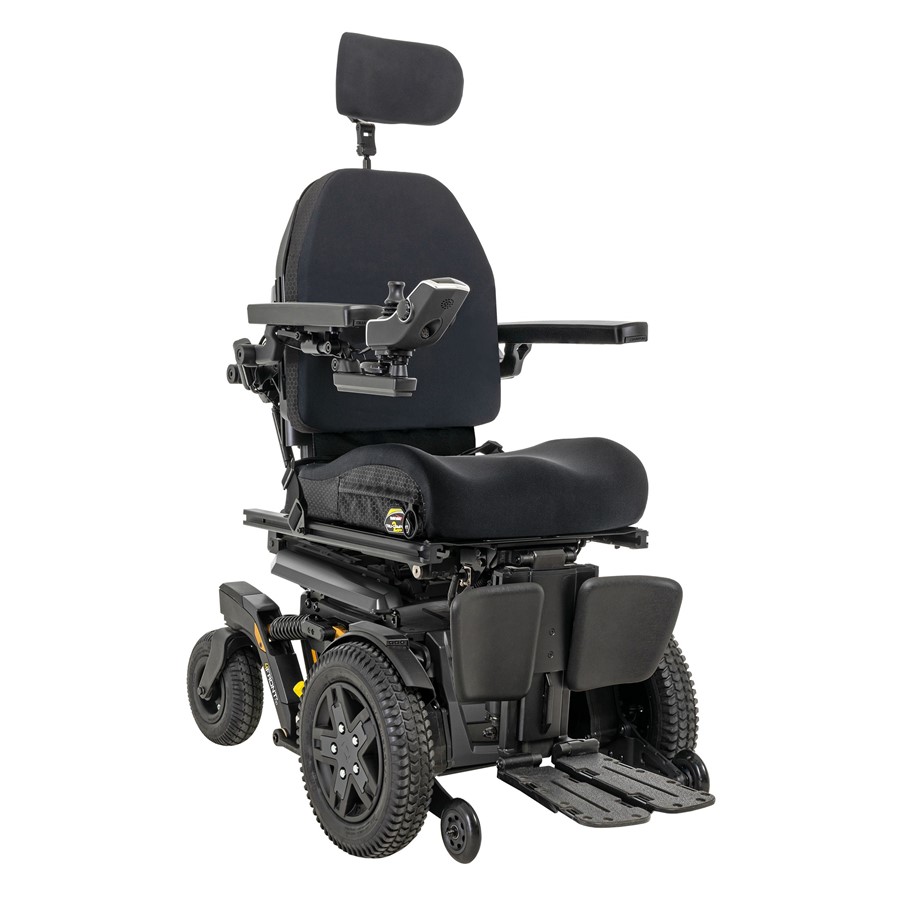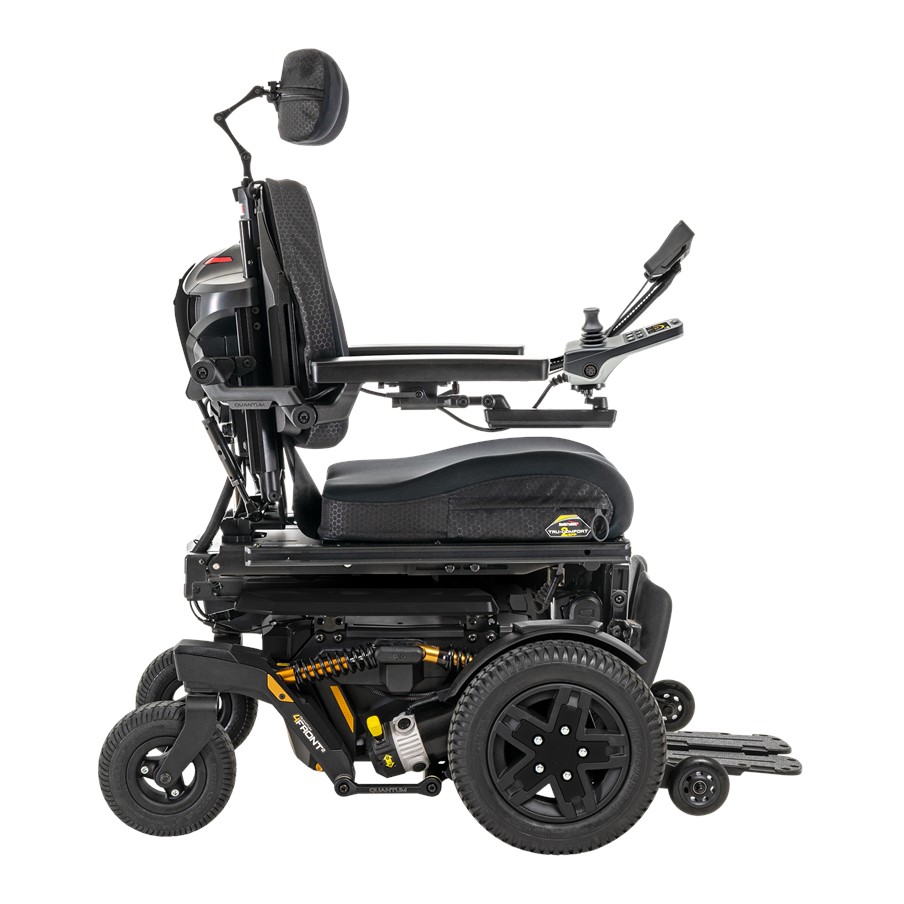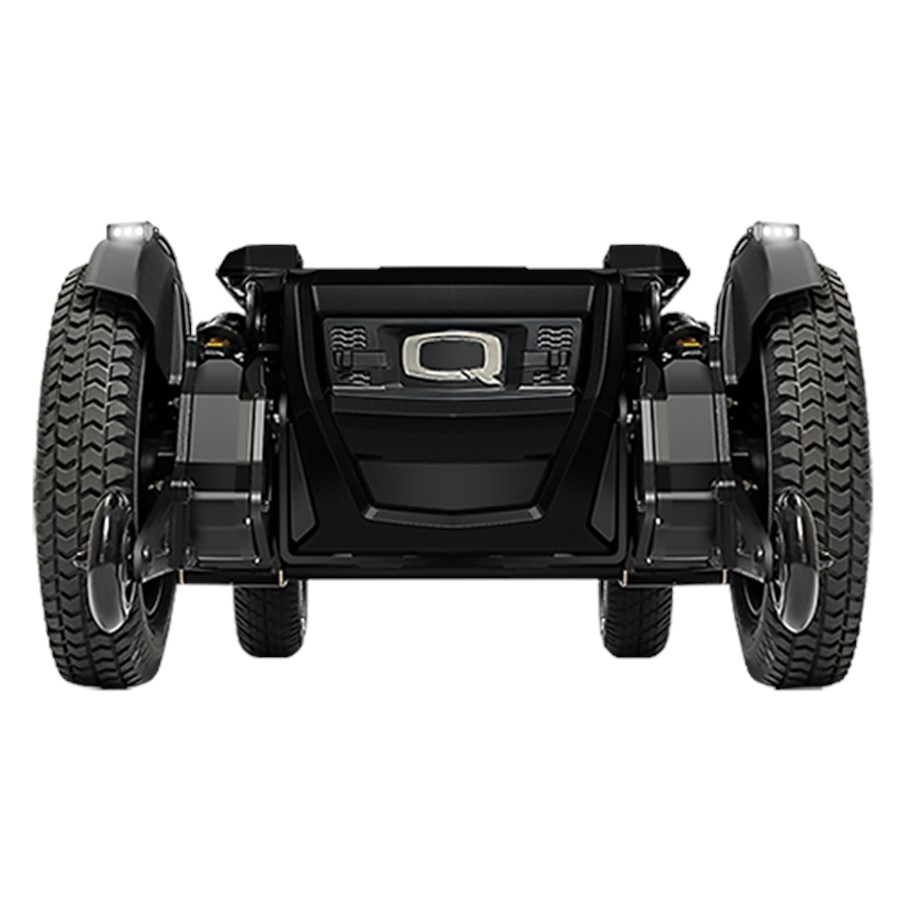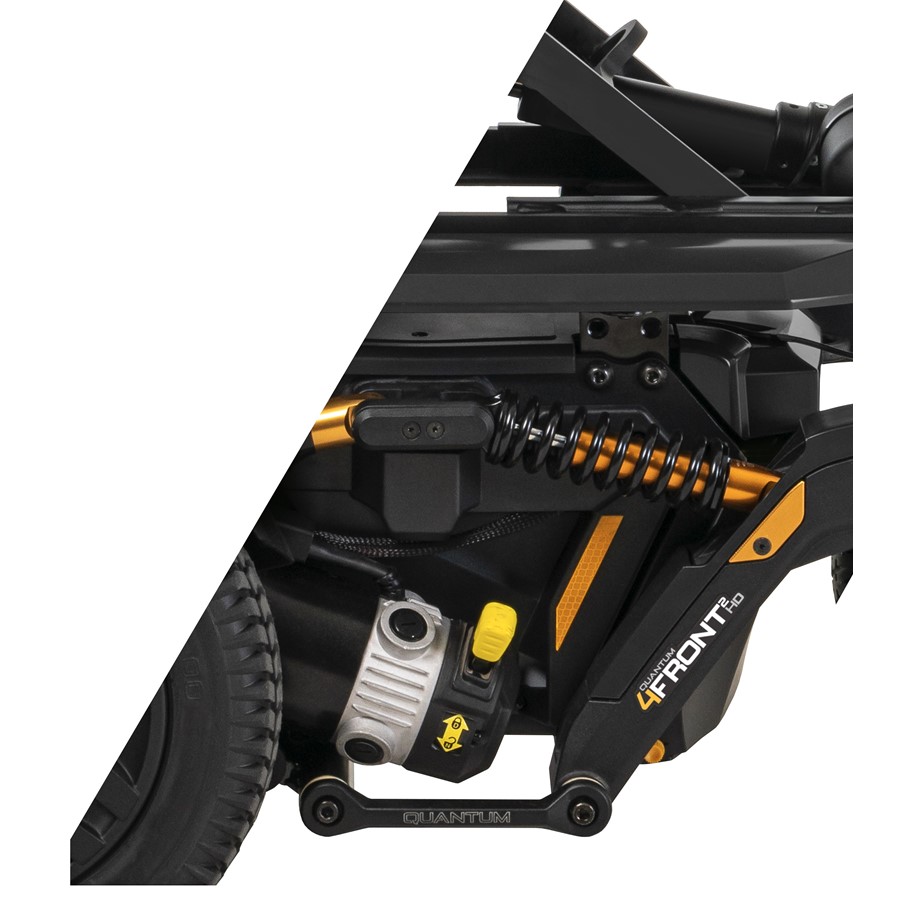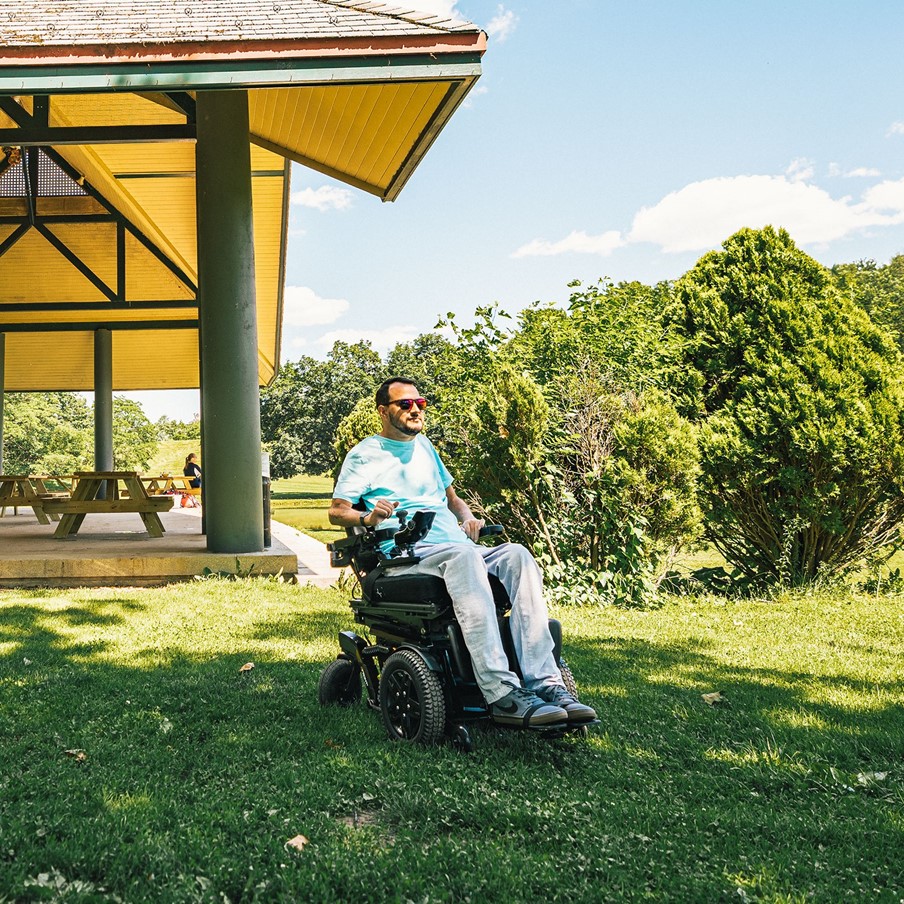Quantum 4Front HD
The 4Front 2 HD is the next generation of the 4Front Power Chair but in a Heavy Duty format! New Smart Traction Control (STC), along with Smooth Ride Suspension (SRS), provide stability for smooth obstacle transitions and unmatched driving performance. Additional new features include 4-pole motors and more robust caster arms. The 4Front 2 HD is a suitable option for users up to 204kg in weight, and 22”s in seated width.
This product is not available in your selected combination
Product Code: {{stockCode}}
Please note the selected product option is not available for trial.
The Quantum 4Front 2 HD offers a full range of powered seating functions, which can be configured on the highly adaptable TRU-Balance 3 HD Seating System.
Features
- Smooth Ride Suspension (SRS) provides a smooth, comfortable ride, reducing overall fatigue, discomfort and allowing for maximum performance. 30% better than previous Quantum suspension options.
- Linak 4-pole motors geared for high torque to accommodate heavier loads
- Up to 8 km/h and 4.3 km/h when elevated
- Smart Traction Control (STC) allowing for straighter drive with minimal client input
- Q-Logic 3 modular expandable electronics that easily allow for the addition of alternative drive controls
- Lift and Tilt with iLevel – allows the user to drive at up to 4.3 km/h when elevated
- Compact full-size front-wheel drive powerchair with 6 wheels on the ground for stability
- Lift and Tilt 10" raise (optional iLevel function)
- Power tilt
- Power elevate
- Power elevating leg rests, swing-away or centre mounted
- Power recline with anti-shear
- Powered vertical lifting platform
- Seat width of 20” – 24” with easy adjustment
- Seat depth of 20” – 22” with easy adjustment (20" - 24" in Static Seat)
- User weight capacity of 204 kg with tilt in space (181.4 kg with lift and tilt)
- LED front and rear fender lights if required
- Unmatched driving performance and ride quality
- Advanced stability for smooth obstacle transitions
- Redesigned caster arms for improved durability and aesthetics and reduced weight
- Quiet ride technology
- Conforms to all applicable ANSI/RESNA, ISO 7176 Series, AS/NZS 3695.2, and EN12184 standards
- Available for trial in Black. Colours may be available for purchase only by special request.
SRS Suspension
The 4Front 2 HD is equipped with independent SRS (Smooth Ride Suspension), which offers increased shock absorption due to the angle of the shocks. Users enjoy maximum obstacle climbing and increased overall comfort. The Quantum 4Front 2 HD front-wheel drive powerbase has been engineered from the ground up with true independent suspension without using an articulating beam. When you want a smooth, comfortable ride, unmatched performance and advanced stability, there’s only one choice: SRS.
Clinical Benefits from SRS
- Transmission of surface inconsistencies is significantly decreased allowing for better management of spasticity and tone.
- SRS can significantly reduce pain for clients due to the reduction in jolting forces directly below the user.
- SRS minimises the displacement of the upper body, head and neck providing a greater sense of stability and less of a reliance on postural components.
- Greatly helps clients using alternative drive control systems or modified joystick handles to maintain contact with the drive control.
| Drive Type | Front-wheel drive |
| Seat Type | TRU-Balance 3 HD Power Tilt / TRU-Balance 3 HD REAC and iLevel |
| User Weight Capacity | 204 kg (181.4 kg with 25.4 cm lift) |
| Seat Width | 20” – 24” (½” increments) |
| Seat Depth | 20” – 22” (20" - 24" for Static Seat) |
| Seat-to-Floor Heights | 16.5" - 20.5" |
| Power Tilt-in-Space | Optional 50° |
| Power Recline | Optional |
| Power Elevate | Optional 10" |
| Manual Tilt-in-Space | Optional |
| Manual Recline | Optional |
| Specialty Controls | Optional |
| Overall Width | 24.3" / 618 mm |
| Overall Length (excluding footplates) | 39.7" / 1010 mm |
| Ground Clearance | 3.15" / 80 mm at battery tray |
| Turning Radius | 24.5" / 623 mm |
| Drive Wheels | 14" flat free |
| Caster Wheels | 9" flat free |
| Anti-Tip Wheels | 4" Flat Free |
| Maximum Rated Slope | 7.5° (13.2%) |
| Suspension | Smooth Ride Suspension (SRS) |
| Motor Type | 4-pole, front-wheel drive |
| Available Electronics | Q-Logic 3 (expandable) or Q Logic 3e |
| Battery Size | 73 Ah |
| Battery Charger | 8A Off-board |
| Maximum Speed | Up to 8km/h and 4.3 km/h when elevated |
| Base Weight | 63.5 kg |
| Battery Weight | 23.36 kg each |
| Warranty | 2 year limited |
What are the different types of powerchairs?
There are 3 distinct styles of powerchair, all of which are categorised by the location of the wheels driving them. They are:
- Rear-wheel drive - the driving wheels are located to the rear of the seated position.
- Mid-wheel drive - the driving wheels are located underneath, or towards the middle of the seated position.
- Front-wheel drive - the driving wheels are located towards the front of the seated position.
Each style of powerchair offers a very different driving sensation, and different advantages/disadvantages to match in relation to the space that it requires to manoeuvre.
Over and above the range of bases with different wheel positions, there is also a wide range of seating options available on powerchairs, to cover a wide range of potential needs. These range from simple slung canvas upholstery to complex motorised seating units, allowing independent positioning of one's body while seated in the chair. For example a powered reclining action, tilt of the whole seat back and elevation of the seat to transfer or get in to cupboards.
As there is no one-size-fits-all solution, powerchairs should be viewed on a case-by-case basis. If you have any further questions regarding a powerchair, or would like to look at the powerchairs available through Allied Medical click here.
What ability do I need to operate a powerchair?
Thanks to huge developments in the electronics arena, powerchairs are now more accessible than they have ever been, and the methods of controlling powerchairs expand from year-to-year. The standard method of control is through a joystick, working on a pushing motion, where the joystick is pushed in the desired direction of movement.
If joystick operation is not a feasible means of control, we are able to harness almost any location on the body, even where movement is very minimal, to offer access to, and total control of, a powerchair, any seating functions the powerchair offers, and access to control of the surrounding environment.
Where can I take a powerchair?
We have people using powerchairs everywhere from mountain bike tracks to farmland, supermarket aisles to footpaths, and of course everywhere in an around the home.
Powerchairs are designed to cope with covering a wide range of terrain, with different models being more appropriate to traversing different surfaces and conditions.
You can assume that any powerchair will be able to cover the majority of surfaces found within your home and community, be it carpet, concrete or grass etc. Obviously, more challenging surfaces i.e. mud; require more competent chairs, of which an appropriate style chair is able to be supplied.
For outdoor environments, most powerchairs will manage a trip down the footpath to the local dairy, but for metal roads and wet sports fields, powerchairs with bigger tyres, motors, batteries and castors are required. These powerchairs tend to be wider and may not fit all home environments.
How frequently can a powerchair be used?
A powerchair can be used as often as you like as it is designed to be there for your assistance as little or much as you need. Charging of the batteries (view the separate FAQ on this page) is advisable to make sure you don’t get stuck on your trip out and about.
How long do the batteries last?
The powerchairs are supplied with batteries matched to the performance required from the chair, and as such the batteries will allow the chair to be used for the duration of the day before needing to be recharged.
Hills, user weight and tyre selection are all elements that impact on how far you can travel on a single charge. In terms of the life of the batteries, one should expect upwards of 12 months from a new set of batteries, depending on their usage and the regularity of their recharging.
How do I recharge it?
A powerchair is supplied with a specific battery charger designed to plug into a socket, usually located on the powerchair hand controller. This charger is then plugged into a regular 3-pin 230V wall socket. The amount of time required to charge the chair will vary, but it is recommended that the chair be charged nightly to ensure a full charge each time use of the chair is required.
Can I travel in my powerchair in a vehicle?
We, along with the manufacturers of many powerchairs, always recommend that it is safest for anyone using a mobility device to transfer to a vehicle seat and use the seatbelt system or child safety seat that meets the New Zealand standards.
If it is not possible to do this, then it is important for the wheelchair / powerchair to be secured to the vehicle facing forward and to use crash tested seatbelts (also attached to the vehicle) for the wheelchair seated rider.
Wheelchairs and powerchairs that have been designed and tested for use as a seat in motor vehicles are the best option. These wheelchairs comply with ANSI/RESNA WC19 which is a voluntary standard developed by safety and rehabilitation experts. Information on this testing is included in manuals that come with each product and stickers like this one are also visible the wheelchair or powerchair itself if it has been tested to this standard.
A wheelchair or powerchair which has been tested to this standard has four, crash tested securement points where tie-down straps and hooks can easily be attached. These points are clearly marked with a hook symbol.
It is important that the Wheelchair Tiedown and Occupant Restraint Systems (WTORS) used within the vehicle is used to secure the wheelchair and provide the occupant with a properly fitting three point lap and shoulder belt. Postural support belts that have been attached to the wheelchair / powerchair are not strong enough to withstand crash forces and are not usually positioned correctly to protect the person safely in an accident.
This must also be crash tested and labelled that it complies with the ANSI/RESNA WC18. This system used four tie down straps or hooks that attach to the wheelchair/powerchair at the securement points marked. The straps need to be tightened to remove any slack.
There are other methods of wheelchair and powerchair securement that can be used, such as a docking system. These are attached to both the mobility device and the vehicle. More information on these should be sought from the product supplier and the wheelchair/powerchair supplier as different systems have been tested with different products.
Other points to note:
- It is best to ride with the backrest of the wheelchair or powerchair positioned at an angle of 30 degrees.
- Maximise the clear space around the rider to avoid any contact with any vehicle components and other passengers in an accident.
- Check the wheelchair and WTORS regularly for any wear and tear and replace any worn components.
- If involved in an accident, check with the supplier/manufacturer if anything needs to be replaced
- A properly positioned headrest should be used to protect the head and neck from rear impact
- Remove any trays to avoid the user making contact with these and potential injury. If the tray cannot be removed, adding soft foam around the user cut-out is recommended to soften the contact point with the user.
- For more information read and follow all the manufacturers’ instructions.
Please remember that wheelchairs and powerchairs have been designed for mobility, not as seats for vehicles.
Can I take my powerchair on a plane?
All airlines have their own specific regulations they adhere to and we recommend that you contact them directly for their detailed guidelines, however the following refers to general information that you may need to consider.
As a general rule, airlines will require all types of wheelchairs to be checked luggage. All powerchairs must be stowed as check-in luggage so it is important to minimise the possibility of damage during transit. We suggest you remove the seat cushions and any other parts that could easily become separated from the chair.
Also, it is probably a good idea to travel with some basic maintenance tools for your powerchair.
It is important to supply your chosen airline with as much information as possible when you make your flight booking. You may need to supply them with some or all of the following information:
- The type of mobility aid you are travelling with (electric or non-electric)
- What type of batteries are used (gel cell (dry) or wet (spill-able)
- Whether the mobility aid is collapsible
- The dimensions (height, width and length) in adjusted or disassembled state and its total weight
For best practise, always contact your chosen airlines for their specific regulations before getting to the airport.
Download our Powerchair Specifications for Flights guide here.
Read more about Travelling with a Powerchair here.
What sort of ongoing maintenance do powerchairs need?
Charging is the most essential maintenance task required of any powerchair, as without this occurring on an ongoing basis the chair will lack the power to perform at its optimum. Correct tyre inflation is also an important maintenance task, to ensure that the chair is operating in the most efficient manner without having increased resistance to battle with. This task can be carried out anywhere with access to compressed air e.g. a petrol station, bike shop etc.
Beyond that, it is important that all bearings and points requiring lubrication are checked and replenished on a frequent basis.
The seating component of a powerchair is unlikely to have any parts requiring ongoing maintenance, though if this were the case, it would be expected that advice on these tasks would be provided by the therapist/supplier at the time of delivery of such an item.
All powerchairs come with user manual. These outline specific requirements for maintenance and servicing and are generally listed in a weekly, monthly and annual servicing format.
What counts towards a powerchair's weight capacity?
A powerchair’s weight capacity includes the combined weight of the user and any accessories mounted to the powerchair. This does not include standard components added to the powerchair base such as seating, backs, cushions and hand controllers, however, does include additional accessories such as cup holders, portable ventilators, CPAP machine’s and holders etc. Please also note, anything temporarily added to your powerchair such as shopping a user may carry also adds to the weight limit. Activities such as weight lifting is not recommended in a powerchair unless the load of the weights does not push the limit over the total capacity.
Who can carry out maintenance on a powerchair?
There are a number of wheelchair technicians located throughout New Zealand, some operating independently, and some operating as a function of a bike shop or the like. They cover all of the major centres, but the majority of maintenance tasks on a powerchair can easily be performed by a range of people from bike mechanics to auto electricians and mechanics. Click here to find one nearest to you.
What is the life expectancy of a powerchair?
It is expected that a powerchair would offer a life in the region of 5 years, where it is being used fairly frequently, but this is greatly dependent on the conditions it is subjected to, and the maintenance that is carried out on the powerchair over its life. On the flip side, it is not uncommon for a powerchair to be continuing active duty well beyond 10 years if well maintained and stored in an appropriate environment.
Can I use my powerchair in the rain/snow?
You can use your powerchair in the rain, however intense or prolonged exposure of your powerchair to rain (or continued dampness) can potentially cause electronic or mechanical malfunctions, as moisture can cause rust and corrosion to various parts. Damage like this would be considered wear & tear.
As part of your powerchair's maintenance you should have it examined periodically for signs of rust from water exposure or any other form of fluid exposure. Damaged components should be replaced or treated immediately.
If your powerchair has come into contact with water you should do the following steps:
- Dry your chair with a towel as thoroughly as possible
- Try to keep the chair in a warm and dry location for 12+ hours to aid with evaporation of any water in inaccessible areas
- Before using the power chair after the 12 hour drying period, test the joystick and brakes on it to ensure they are functioning correctly
- If you discover any issues with the powerchair get in touch with your local sub-contractor for support
